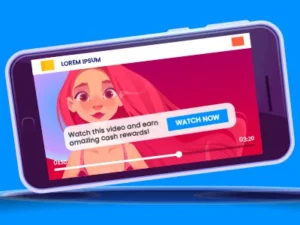
Have you ever been scrolling through websites and suddenly come across an ad that feels tailor-made for you? It’s not just a coincidence, and it’s also not because your phone is listening to your conversations.
Next time you see an ad for your favourite hobby, the shoes you’ve been eyeing for a while, or that new gadget you’ve been researching, know that it’s not magic. What you’re seeing is a marketing strategy known as programmatic advertising.
Programmatic advertising has been a hot topic in the marketing world for a considerable period of time. On mobile, gaming is already a top spending vertical and a leading innovator, accounting for 50% of total ad spend in the industry.
In this fierce competition, more than placing ads in front of an audience is required. There must be suitable ad campaigns, that reach the right users at the right moment. Programmatic mobile advertising is the best method to deliver the right ads to the right segment of users.
In this blog, we will understand programmatic advertising, its features and how it has become the best choice for marketers.
What is programmatic advertising?
In programmatic advertising, ads are bought and sold automatically. It is like a personalised and targeted way of showing online ads, where AI and machine learning algorithms are used to predict who might like the ads and when to show them.
According to the latest estimates, programmatically sold advertising was worth 546 billion U.S. dollars in 2023. This figure is expected to reach $779 billion by 2028.
In 2024, programmatic advertising is expected to gain even more traction, as advertisers seek to reach their desired audience more effectively while providing relevant content to users.
Programmatic advertising vs. digital advertising
While digital advertising aims for wide reach and audience discovery, programmatic advertising uses precise targeting based on real data to segment audiences effectively.
Programmatic advertising integrates technological advancements with human expertise to optimise ads and revenue.
Also Read: Why HTML5 is considered the future of online gaming?
How does programmatic advertising work?
Programmatic advertising is an automated process that works within the parameters defined by advertisers. It purchases digital ad space across various mobile, web, social media, and video platforms.
This advertising method uses workflow automation and machine learning algorithms to ensure that the most effective ads are delivered to audiences. These ads are tailored based on various signals, such as shopping patterns.
Programmatic advertising includes SSPs, DSPs, ad exchanges and DMPs. So, before understanding how it works, we should understand these terms.
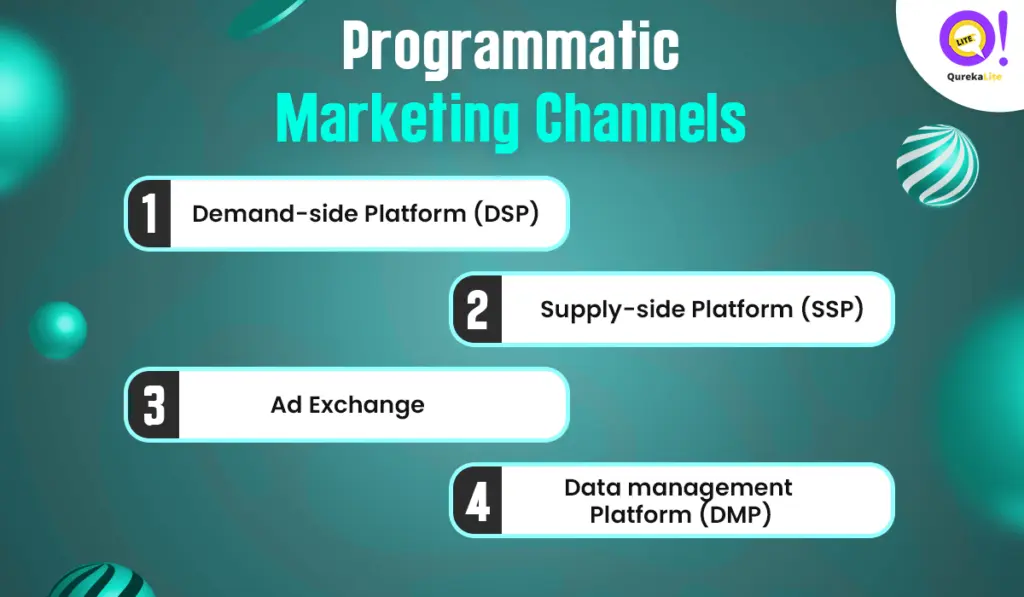
What is a demand-side platform (DSP)?
A demand-side platform (DSP) is programmatic software for advertisers to purchase ad inventory across multiple platforms at once. DSPs help brands and agencies determine which impressions to buy and at what price. Advertisers can select audiences based on demographics, shopping patterns, browsing history, and user behaviour. Display & Video 360 by Google, The Trade Desk, and Amazon DSP are some examples of DSPs.
What is a supply-side platform (SSP)?
A supply-side platform (SSP) is programmatic software for publishers that allows them to sell ad impressions across various formats to potential buyers automatically and in real-time. It lets publishers have full control over their inventory, which can be optimised by setting favourable bidding ranges. Google Ad Manager, Amazon Publisher Services, OpenX, Google AdMob, and Yahoo Ad Tech are some popular examples of SSPs.
What is an ad exchange?
In programmatic advertising, an ad exchange is an online marketplace where ads are bought and sold quickly. These ad exchanges bring together various entities, such as advertisers, agencies, demand-side platforms, publishers, and supply-side platforms. Google Ad Exchange and Xandr by Microsoft are popular ad exchanges.
Also Read: What Are Ad Servers and How to Choose the Right One?
What is a data-management platform (DMP)?
DMPs are highly analytical programmatic advertising buying platforms. They collect and analyse all the diverse data about online users, helping advertisers understand their audience on a deeper level and enabling precise targeting of ads.
How does the programmatic media buying process work?
When a person clicks on a website or opens an app, the site’s owner notifies one or multiple ad exchanges to put the ad space up for auction. This task is carried out by a Supply-Side Platform (SSP).
DSPs (demand side platforms) assist in purchasing ad inventory on the open market and targeting the desired audience with the help of DMPs (data management platforms) integration.
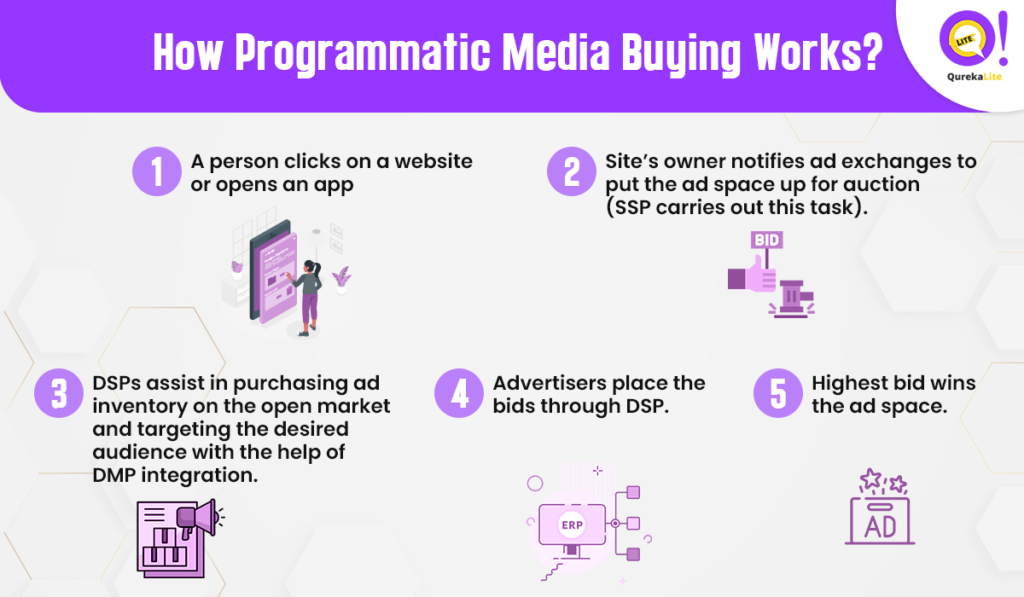
DMPs gather and analyse cookie data to help marketers make more informed decisions about their target audience by considering various factors such as location, demographics, user behaviour and online activity.
DMPs also consider contextual targeting, which analyses website content, including text, keywords, images, and categories to show ads on web pages having content closely related to your products or services.
DSP places the bid and the highest bidder wins the ad space.
This way, the winning bidder’s ad is served on the site. All this takes place in a hundredth of a second.
How much does programmatic advertising cost?
Programmatic advertising costs can vary based on the cost per 1,000 ad impressions, commonly known as CPM (cost per mille).
The more specific targeting you need, the higher the cost you need to pay. However, the actual cost depends on factors such as the type of industry, targeted device, ad format, and ad placement.
Also Read: How to make money with your website/app In 2024?
What are the types of programmatic advertising?
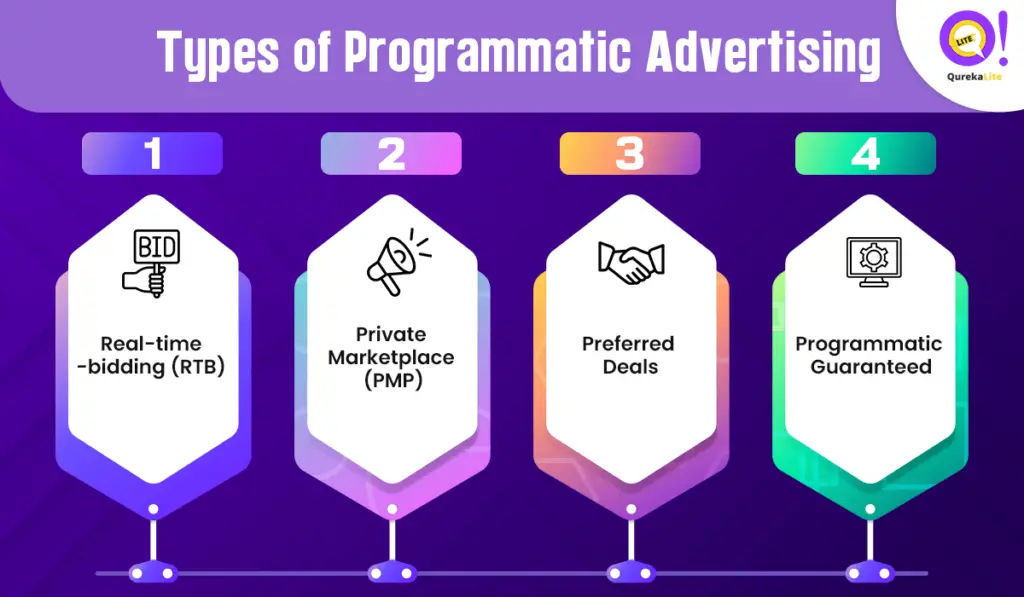
Real-time-bidding (RTB)
RTB is the most commonly used type of programmatic advertising, also known as an open auction. As the name suggests, the ad slots are open to everyone and sold through an open auction type of bidding conducted in real-time. The advertisers can bid for the slots as they become available, with the highest bidder winning the ad space.
Private Marketplace (PMP)
The private marketplace functions similarly to the RTB except that it is available to advertisers on an invite-only basis. In a private or closed auction, several publishers invite specific advertisers to bid on their ad inventory. This type of auction bypasses ad exchanges and enables a direct connection between advertisers and publishers.
Preferred Deals
A preferred deal is a special type of programmatic auction where publishers offer premium ad space directly to a selected group of advertisers at a predetermined cost per thousand impressions (CPM). In this arrangement, advertisers bid in real-time, either meeting or surpassing the fixed CPM price to secure the ad space.
Programmatic Guaranteed
Programmatic guaranteed, also known as programmatic direct or automated guaranteed is a traditional approach to media buying where no auction bidding occurs. Instead, the publisher and advertiser negotiate the terms and price for ad inventory one-to-one.
Also Read: What are some of the best mobile gaming trends in 2024
What are the benefits of Programmatic advertising?
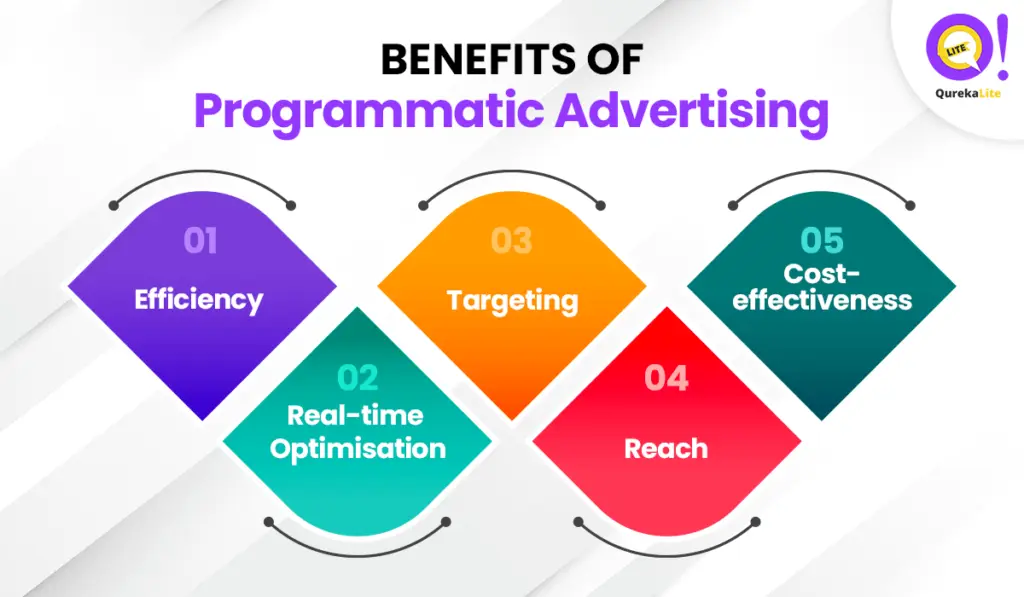
Programmatic advertising is continually working towards identifying and solving the issues faced by advertisers and marketers, such as accessing the ad inventory. This means that large chunks of ad space went unsold. Automation solved this problem by making it easier to buy ad inventory. The following are some of the top benefits of programmatic advertising that can help improve any marketing campaign:
Efficiency: Programmatic advertising simplifies purchasing ads by automating tasks traditionally done manually, saving time and resources.
Real-time Optimization: Programmatic advertising utilises data insights and algorithms to optimise campaigns in real-time, resulting in enhanced ad performance and return on investment (ROI).
Targeting: Programmatic advertising helps in precise audience targeting based on demographics, interests, and user behaviour. This improves user engagement by showing the relevant ad to the relevant audience.
Reach: Programmatic advertising helps advertisers expand their reach to a larger audience across various channels such as websites, mobile apps, social media platforms, and video streaming services, managed from a single platform.
Cost-effectiveness: Programmatic advertising targets specific audiences and optimises ad spending in real-time, resulting in better outcomes at a lower cost compared to traditional advertising methods.
How can you launch a successful programmatic advertising campaign?
After learning about programmatic advertising, let’s explore some tips for a successful campaign.
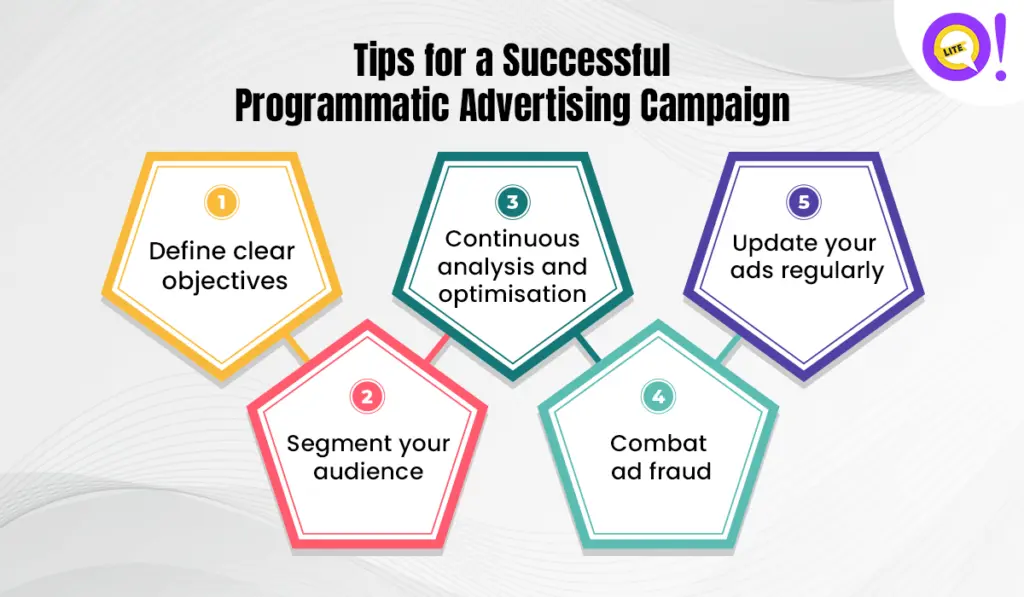
Define clear objectives
You should use existing data to determine the type of advertising awareness you need, whether it’s increasing brand awareness, driving website traffic, or boosting sales. Then, build an effective strategy that works with your short- and long-term goals.
Segment your audience
Understand your target audience thoroughly by researching their demographics, interests, and behaviours, then utilise precise audience targeting to reach the right people with your ads, maximising relevance and engagement. Segmenting users into different groups, helps you to design ads for specific people. This will add personalisation to your campaigns.
Continuous analysis and optimisation
As your ads appear across various channels and devices, use attribution models to understand performance on each platform. Various attribution models help you evaluate the performance across individual platforms and the campaign. This way, you can identify successful campaigns and those that need improvement.
Combat ad fraud
Programmatic ad fraud involves generating fake impressions, using non-human traffic such as bots, stacking multiple ads in one space, spoofing domains, and engaging in click fraud. Advertisers risk paying for interactions that don’t lead to real user engagement or conversions.
This damages the reliability and efficiency of programmatic advertising, causing financial harm and undermining trust in the industry. Fighting ad fraud demands strong fraud detection methods, clear reporting, and cooperation among stakeholders to maintain the credibility of digital advertising.
Also Read: Offerwall Ads Guide to Enhance User Retention And Monetization In 2024
Update your ads regularly
Repeatedly encountering the same ads can lead to irritation, even with high-quality creative content. Analysing performance and applying frequency caps is the solution.
Frequency caps enable you to regulate the number of times specific users see an ad within set time frames, like monthly, weekly, or hourly.
By understanding this data, you can recognise individual users across various channels and prevent them from being bombarded with the same ad across all platforms they visit.
Conclusion
In summary, programmatic advertising has changed digital marketing by helping advertisers reach the right people more easily and effectively. It uses advanced technology to deliver personalised ads to specific users at the best times and places. While it offers many benefits like saving time and money, running successful campaigns means planning carefully, studying the audience, and watching out for fraud. Using programmatic advertising for ad campaigns can lead to big results and success in today’s digital world.




